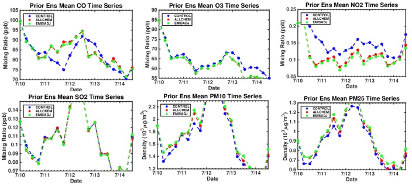Air Quality Modeling and Emission Estimation
At NASA ARC we are applying WRF-Chem/DART to the Front Range Air Pollution and Photochemistry Experiment (FRAPPE) at medium horizontal resolution (15 km grid scale) to study the impact of chemical data assimilation with dynamic emissions estimation on air quality (AQ) modeling for July 15 – 24, 2014. For these experiments we assimilate: (i) conventional meteorological observations; (ii) EPA Air Quality System (AQS) surface AQ observations (carbon monoxide (CO), ozone (O3), nitrogen dioxide (NO2), sulfur dioxide (SO2), and particulate matter (PM; in the form of PM with radii less than 10 µm (PM10) and PM with radii less the 5 µm (PM5)); and (iii) satellite observations (MOPIT and IASI CO profile, MODIS aerosol optical depth (AOD) total column, OMI O3 profile, NO2 and SO2 tropospheric column retrievals). We compare three types of experiments: (i) M-CONTROL – where we assimilate only meteorological observations; (ii) M-ALLCHEM – the same as M-CONTROL, but we also assimilate chemistry observations; and (iii) M-EMISADJ – the same as M-ALLCHEM, but we include dynamic emissions estimation (apply ‘top-down’ emissions estimation at each cycle time). Figure 1 show vertical profile results from this study with forecast skill metrics:
‘root mean square error’ (RMSE) and ‘BIAS’. The results show that M-ALLCHEM had improved skill compared to M-CONTROL and that M-EMISADJ had improved skill compared to M-EMISADJ. These results demonstrate the benefit of chemical data assimilation and dynamic emissions estimation.
We are conducting similar studies at very high resolution (4 km grid scale) for a domain that cover the state of Colorado (the COLORADO application). For these experiments, we assimilate meteorological and AQS observations that are similar to those for the FRAPPE application except they are for a different time frame (July 10 – 18, 2020) and horizontal domain (Colorado as opposed to the western continental United States). We assimilate the following satellite observations: MOPITT CO profile; MODIS aerosol optical depth (AOD) total column; TROPOMI CO total column, O3 profile, NO2 and SO2 tropospheric column; and proxy TEMPO O3 profile and NO2 tropospheric column retrievals. We do not have validation data for this application. The experiment identifiers are the same as for the FRAPPE application except we drop the M- prefix. Figure 2 shows that: (i) at very high resolution the ALLCHEM and EMISADJ results remain reasonable, and (ii) we can assimilate proxy TEMPO retrievals.






























